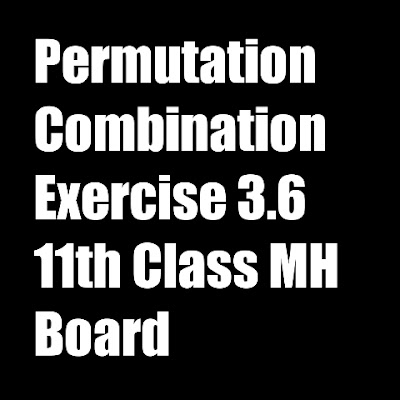9. After meeting every participant shake hands with every other participant. If the number of handshakes is 66 find the number of participants in the meeting.
Answer-
Let there be n participants present in the meeting.
A handshake occurs between 2 persons.
∴ Number of handshakes = nC2
Given 66 handshakes were exchanged.
∴ 66 = nC2
∴ 66 =$\frac{n!}{2!(n-2)!}$
∴ 66 × 2 =$\frac{n(n-1)(n-2)!}{(n-2)!}$
∴ 132 = n(n – 1)
∴ n(n – 1) = 12 × 11
Comparing on both sides, we get
n = 12
∴ 12 participants were present at the meeting.
10. If 20 points are marked on a circle how many chords can be drawn?
Answer-
There are 20 points on a circle.To draw a chord, 2 points are required.
∴ the number of chords that can be drawn through 20 points on the circle.
= 20C2
$=\frac{20!}{{2!18!}$
$=\frac{20×19×18!}{{2×1×18!}$
= 190.
11.find the number of diagonals of an n sided polygon. In particular, find the number of diagonals when.
a) n=10 b)n=15 c)n=12 d)n =8
Answer-
a)In an n-sided polygon, there are ‘n’ points and ‘n’ sides.
∴ Through ‘n’ points we can draw nC2 lines including sides.
∴ Number of diagonals in n sided polygon.
= nC2 – n .........(n = number of sides)
n = 10
nC2 – n = 10C2 – 10
$\frac{{10.9}}{1.2}}-10$
= 45 – 10
= 35
b)There are n vertices in the polygon of n-sides.
If we join any two vertices, we get either side or the diagonal of the polygon.
Two vertices can be joined in nC2 ways.
∴ total number of sides and diagonals = nC2 But there are n sides in the polygon.
∴ total number of the diagonals = nC2 – n
n = 15 sides
∴ the number of diagonal that can be drawn.
= 15C2 – 15
=$\frac{15×14×13!}}{2×13!}$-15
=15×142-15
= 105 – 15
= 90
c)In an n-sided polygon, there are ‘n’ points and ‘n’ sides.
∴ Through ‘n’ points we can draw nC2 lines including sides.
$∴ Number of diagonals in n sided polygon.$
= nC2 – n ...(n = number of sides)
n = 12,
nC2 – n = 12C2 – 121
=\frac{2×11}{1×2}-12
= 66 – 12
= 54
d)There are n vertices in the polygon of n-sides.
If we join any two vertices, we get either side or the diagonal of the polygon.
Two vertices can be joined in nC2 ways.
∴ total number of sides and diagonals = nC2
But there are n sides in the polygon.
∴ total number of the diagonals = nC2 – n
n = 8 sides
∴ the number of diagonals that can be drawn
Permutation Combination Exercise 3.1
Permutation Combination Exercise 3.2
Permutation Combination Exercise 3.3
Permutation Combination Exercise 3.4
Permutation Combination Exercise 3.5
 |
| Permutation and Combination Exercise 3.6 11th Class MH Board |
Permutation and Combination Exercise 3.6 11th Class MH Board







